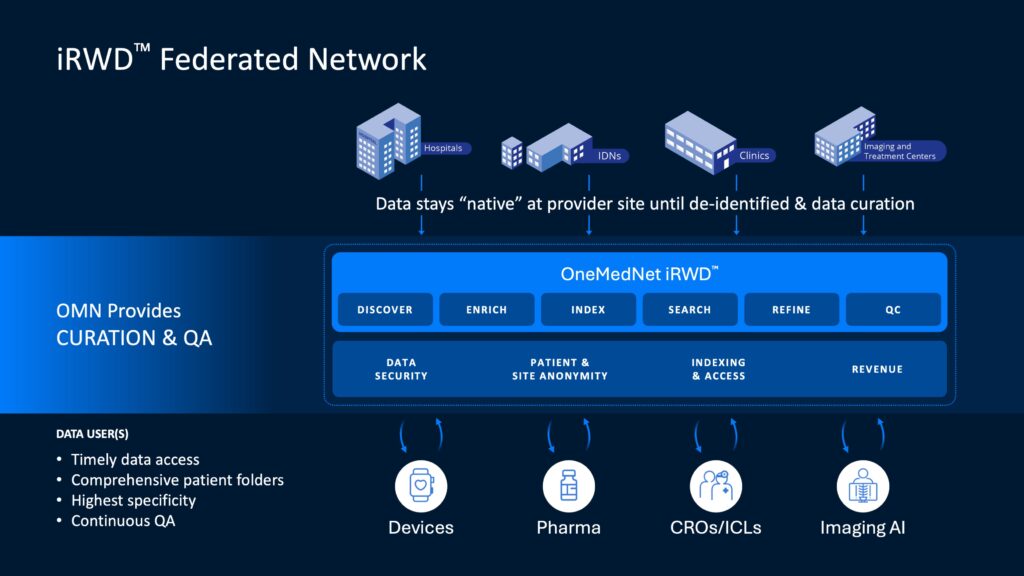By Melane Sampson

OneMedNet (NASDAQ:ONMD) is delivering seamless access to regulatory-grade imaging real-world data (RWD) by employing its proprietary iRWD network and platform to de-identify, search, and curate data revealing an unprecedented wealth of internal and third-party research opportunities to its drug, medical device, and imaging/diagnostic AI development customers.
“OneMedNet is driving healthcare innovation by harnessing the full potential of RWD to unlock the value contained within clinical data repositories through its robust iRWD platform that provides secure, comprehensive management of diverse clinical data types including electronic health records, laboratory results, and medical imaging data,” Mr. Aaron Green, President and CEO of OneMedNet says in an interview with BioTuesdays.

By leveraging its extensive federated provider network complemented with leading-edge technology and in-house clinical expertise, OneMedNet meets the most rigorous of real-world data life sciences requirements, delivering de-identified and hard-to-curate information in a well-organized way that is meaningful to research, he adds.
OneMedNet connects independent clinics, hospitals, and integrated delivery networks into a single federated database enabling researchers to know where patients are located throughout North America. Hospital and clinic partners provide the company with full access to electronic health records, including medical imaging data. The iRWD platform allows access to the most up-to-date, real-time data and enables the company to update data fields as requested by researchers.

Mr. Green explains that hospitals have terabytes of patient data in storage but it has been traditionally scarce and biased as well as costly for researchers to access diverse data, de-identify it, and pull it together to create a cohort. “What we provide to the world is an innovative solution – the iRWD platform takes the legwork out and simplifies the process for both researchers and hospitals,” he says.
OneMedNet enables hospitals to participate in delivering valuable data to research for reimbursement while offering researchers the best product available at a lower cost, he adds.
The company also captures data from clinics conducting outpatient procedures. “We can access all of the relevant data that a life sciences organization is looking for because we are not just limited to in-patient data – we also have access to valuable data from procedures that are being conducted in outpatient centers,” Mr. Green says.
Mr. Green notes that OneMedNet combines modern technology with clinical knowledge, highlighting that the company’s in-house curators have deep roots in hospital patient care enabling the team to adeptly interpret clinical notes and render the data relevant to a particular cohort and the research that is being conducted.
“There are other institutions that are creating a window to their data but they don’t allow the data out of their hands so researchers have to stay within their environment,” Mr. Green contends. “One of the differentiating points with the iRWD solution is that OneMedNet offers a licensing agreement that permits research teams to obtain regulatory-grade, real-time data and utilize their own tool sets which of course translates into increased efficiencies.”
Moreover, Mr. Green says in addition to understanding the data and knowing where the data is, OneMedNet can add to that data over time. “So, if we start a study, and six months later researchers need an update on the whole patient population, we can do that.”
Recently, the company announced a greater than five-fold expansion of its iRWD network and platform through a series of new network partnership agreements, including one recently signed with an undisclosed nationwide medical records custodian.
“We are now offering our growing customer base seamless access to an expanded set of RWD across our robust network comprised of 1,402 healthcare system and provider partner sites, 31 million patients, and 121.4 million exams,” Mr. Green says. “As demonstrated by this significant expansion of our network, we continue to successfully execute against the key pillars of our growth strategy.”

OneMedNet’s focus is on three target markets including AI imaging, drug development, and devices and medical implants according to Mr. Green.
“In AI imaging, we cater to customers that are seeking to use data to train algorithms to track and understand different markers such as tumor lesions,” he says.
When it comes to imaging, OneMedNet uses AI to automate reducing costs and time. “The speed and precision we offer is a real differentiator for us over traditional methodologies that other companies have been using for the past ten years,” he adds.
Regarding drug development, Mr. Green maintains that the company is uniquely positioned to provide cohorts well-suited as control arms of clinical trials leveraging the data of patients who have progressed through the disease and have an outcome, drastically reducing trial costs. “This cost savings can enable researchers to spend more time recruiting patients who will receive the drug.”
Pertaining to devices and medical implants, Mr. Green says companies are increasingly looking to leverage the use of existing RWD, particularly medical imaging data, across many stages of development, from ideation up to and including post-market surveillance. “Just last week, we announced entering into a master services agreement with a top-10 global medical technology company that affects more than 150 million patients worldwide annually. We believe this deal with a global leader demonstrates the growing industry awareness and adoption of our highly differentiated iRWD platform.”
In summary, Mr. Green points out that OneMedNet’s network and platform allow for a secure search, de-identification, and curation all done by the company with ease of access to relevant data which in turn impacts patient outcomes because it reduces the time to market for critical therapeutics and drugs.
“It’s all about providing clinical data – and we have access to all of it – that is relevant to life sciences organizations and significantly reducing the time to get that data from months down to weeks because we’re automating the process,” Mr. Green explains. “So, we discover data faster because we’re using modern technology, pulling it very quickly and easily from the live environment, and delivering it faster because we have AI-driven technology to automate the workflow, specifically in the de-identification of data,” he adds.
Looking forward, Mr. Green says, “OneMedNet is focused on building the right relationships and attracting the right hires to grow the organization and build out a pipeline of real-time data moving from providers to life sciences organizations at a rate that has never been seen before.”
• • • • •
To connect with OneMedNet or any other companies featured on BioTuesdays, send us an email at [email protected].






